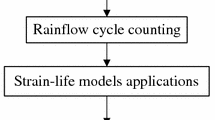Abstract
This article reviews the basic techniques employed in fatigue life prediction. The stress-life, local-strain, and fracture-mechanics methods as applied to life prediction under constant amplitude loading and variable amplitude loading are discussed. Life prediction methodology under variable maplitude loading is also discussed, with particular emphasis on the linear-damage accumulation approach, or Miner's rule. Finally, a discussion of various cycle-counting techniques for variable amplitude loading is given.
Similar content being viewed by others
References
S. Suresh,Fatigue of Materials, (New York: Cambridge University Press, 1991).
N.E. Dowling,J. of Materials (3) (1972), pp. 71–82.
N.E. Dowling,Mechanical Behavior of Materials, Englewood Cliffs, Prentice Hall, 1993).
C.C. Osgood,Fatigue Design, 2nd ed, New York: Pergamon Press, 1982).
G.E. Dieter,Mechanical Metallurgy, 3rd ed., New York: McGraw-Hill, 1986).
H. Neuber,J. of App. Mech., 28 (1961), pp. 544–550.
J.H. Crews,Effects of Loading Sequence for Notched Specimens Under High-Low Two-Step Fatigue Loading, NASA TN D-6558 (November 1971).
V. Kliman, P. Füleky, and J. Jelemenski,Advances in Fatigue Lifetime Predictive Techniques, ASTM-STP 1292, 3rd vol., eds. M.R. Mitchell and R.W. Landgraf, Philadelphia, PA: ASTM, 1996), pp. 305–327.
S.M. Tipton and D.A. Newburn,Advances in Fatigue Lifetime Predictive Techniques ASTMSTP 1122, eds. M.R. Mitchell and R.W. Landgraf, (Philadelphia, PA: ASTM, 1992), pp. 369–382.
M. Vormwald, P. Heuler, and T. Seeger, in Ref., pp. 28–43.
P.C. Paris and F. Erdogan,Trans. of the ASME J. of Basic Engrg. 89 (1967), pp. 528–534.
R. Sunder, in Ref. 9, pp. 161–175.
A.T. Chang et al.Advances in Fatigue Lifetime Predictive Techniques, ASTMSTP 1292, 3rd vol. eds. M.R. Mitchell and R.W. Landgraf (Philadelphia, PA: ASTM, 1996), pp. 100–115.
J.C. Newman et al., in Ref. 9, pp. 5–27.
D. Broek,The Practical Use of Fracture Mechanics (Boston: Kluwer Academic Publishing, 1989).
P.K. Liaw et al.,Acta Met., 30 (1982), pp. 2071–2078.
P.K. Liaw, T.R. Leax and W.A. Logsdon,Acta Met., 31 (1983), pp. 1581–1587.
P.K. Liaw,Acta Met., (1985), p. 33.
P.K. Liaw, T.R. Leax and J.K. Logsdon,Acta Met., 31 (1983), pp. 1581–1587.
J. McKittrick,Met. Trans., 12A (1981), p. 1535.
S. Suresh and P.O. Ritchie:Met. Trans., 13A (1982), p. 1627.
N. Minakawa and A.J. McEvily,Scripta Metallurgica, 15 (1981), p. 633.
D.L. Davidson,Fatigue of Engineering Materials and Structures, 3 (1980), p. 229.
C.M. Hudson and P.E. Lewis,Part-Through Crack Fatigue Life Prediction, ASTM ASP 687, ed. J.B. Chang, Philadelphia, PA: ASTM, 1979), pp. 113–128.
D. BroekElementary Engineering Fracture Mechanics, Boston, MA: Martinus Nijhoff Publishers, 1982).
S. Shanmugham and P.K. Liaw:ASM Handbook, Fatigue and Fracture, vol. 19, Materials Park, OH: ASM, 1996), pp. 210–223.
N.E. Dowling and J.A. Begley,Mechanisms of Crack Growth ASTM STP 590 (Philadelphia: ASTM, 1976).
ASTM Standard E 647,1995 ASTM Standards, 03.01.
F. Xiangjiong,Engineering Fracture Mechanics, 34 (5–6) (1989), pp. 1241–1248.
M.A. Miner,Trans. of the ASME, 67 (1945).
H.A. Lipsitt, D.F. Frank, and G.C. Smith,Proceedings of the Air Force Conference on Fatigue and Fracture of Aircraft Structures and Materials, AFFDI, TR 70-144, eds. H.A. Wood, et al. Washington, D.C. USAF, December 1969).
S.S. Manson, J.C. Freche, and C.R. Ensign,Application of a Double Linear Damage Rule to Cumulative Fatigue. NASA TN D-3839 (April 1967).
H. Alawi,Trans. of the ASME, Journal of Engineering Materials and Technology, 111 (4) (October 1989) pp. 338–344.
ASTM Standard E 1049,1995 ASTM Standards, 03.01.
M. Kato et al,Scripta Metallurgica, (1984), p. 18.
M. Kato and T. Mori,Mechanics of Materials, 13 (2) (March 1992), pp. 155–163.
S.E. Harvey, P.G. Marsh, and W.W. Gerberich,Acta Met. et Mat., 42 (10) (1994), pp. 3493–3502.
M.-R. Lin, M.E. Fine, and T. Mura,Acta Met., 34(4) (1986).
Additional information
R.K. Holman earned his B.S. in materials science and engineering at the University of Tennessee-Knoxville in 1996. He is entering graduate school this fall at the Massachusetts Institute of Technology. Mr. Holman is member of TMS.
P.K. Liaw earned his Ph.D. in materials science and engineering at Northwestern Univeristy in 1980. He is currently a professor and Ivan Racheff Chair of Excellence in the Department of Materials Science and Engineering at the University of Tennessee. Dr. Liaw is also a member of TMS.
Rights and permissions
About this article
Cite this article
Holman, R.K., Liaw, P.K. Methodologies for predicting fatigue life. JOM 49, 46–52 (1997). https://doi.org/10.1007/BF02914767
Issue Date:
DOI: https://doi.org/10.1007/BF02914767




